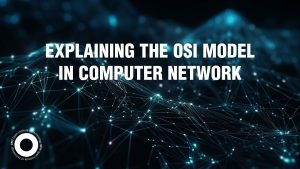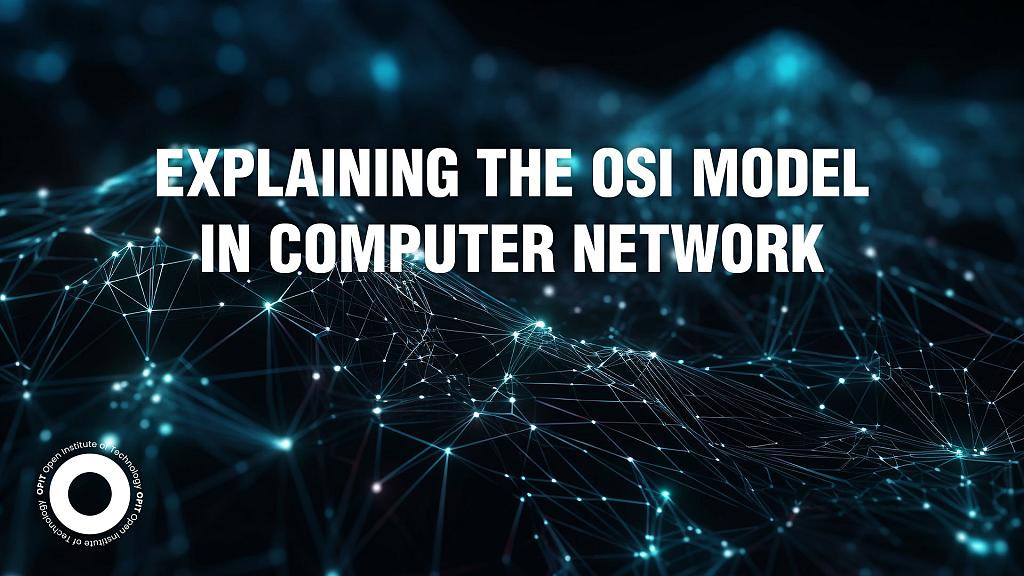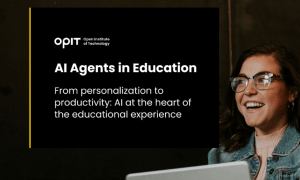

As computing technology evolved and the concept of linking multiple computers together into a “network” that could share data came into being, it was clear that a model was needed to define and enable those connections. Enter the OSI model in computer network idea.
This model allows various devices and software to “communicate” with one another by creating a set of universal rules and functions. Let’s dig into what the model entails.
History of the OSI Model
In the late 1970s, the continued development of computerized technology saw many companies start to introduce their own systems. These systems stood alone from others. For example, a computer at Retailer A has no way to communicate with a computer at Retailer B, with neither computer being able to communicate with the various vendors and other organizations within the retail supply chain.
Clearly, some way of connecting these standalone systems was needed, leading to researchers from France, the U.S., and the U.K. splitting into two groups – The International Organization for Standardization and the International Telegraph and Telephone Consultive Committee.
In 1983, these two groups merged their work to create “The Basic Reference Model for Open Systems Interconnection (OSI).” This model established industry standards for communication between networked devices, though the path to OSI’s implementation wasn’t as clear as it could have been. The 1980s and 1990s saw the introduction of another model – The TCP IP model – which competed against the OSI model for supremacy. TCP/IP gained so much traction that it became the cornerstone model for the then-budding internet, leading to the OSI model in computer network applications falling out of favor in many sectors. Despite this, the OSI model is still a valuable reference point for students who want to learn more about networking and still have some practical uses in industry.
The OSI Reference Model
The OSI model works by splitting the concept of computers communicating with one another into seven computer network layers (defined below), each offering standardized rules for its specific function. During the rise of the OSI model, these layers worked in concert, allowing systems to communicate as long as they followed the rules.
Though the OSI model in computer network applications has fallen out of favor on a practical level, it still offers several benefits:
- The OSI model is perfect for teaching network architecture because it defines how computers communicate.
- OSI is a layered model, with separation between each layer, so one layer doesn’t affect the operation of any other.
- The OSI model offers flexibility because of the distinctions it makes between layers, with users being able to replace protocols in any layer without worrying about how they’ll impact the other layers.
The 7 Layers of the OSI Model
The OSI reference model in computer network teaching is a lot like an onion. It has several layers, each standing alone but each needing to be peeled back to get a result. But where peeling back the layers of an onion gets you a tasty ingredient or treat, peeling them back in the OSI model delivers a better understanding of networking and the protocols that lie behind it.
Each of these seven layers serves a different function.
Layer 1: Physical Layer
Sitting at the lowest level of the OSI model, the physical layer is all about the hows and wherefores of transmitting electrical signals from one device to another. Think of it as the protocols needed for the pins, cables, voltages, and every other component of a physical device if said device wants to communicate with another that uses the OSI model.
Layer 2: Data Link Layer
With the physical layer in place, the challenge shifts to transmitting data between devices. The data layer defines how node-to-node transfer occurs, allowing for the packaging of data into “frames” and the correction of errors that may happen in the physical layer.
The data layer has two “sub-layers” of its own:
- MAC – Media Access Controls that offer multiplexing and flow control to govern a device’s transmissions over an OSI network.
- LLC – Logical Link Controls that offer error control over the physical media (i.e., the devices) used to transmit data across a connection.
Layer 3: Network Layer
The network layer is like an intermediary between devices, as it accepts “frames” from the data layer and sends them on their way to their intended destination. Think of this layer as the postal service of the OSI model in computer network applications.
Layer 4: Transport Layer
If the network layer is a delivery person, the transport layer is the van that the delivery person uses to carry their parcels (i.e., data packets) between addresses. This layer regulates the sequencing, sizing, and transferring of data between hosts and systems. TCP (Transmission Control Protocol) is a good example of a transport layer in practical applications.
Layer 5: Session Layer
When one device wants to communicate with another, it sets up a “session” in which the communication takes place, similar to how your boss may schedule a meeting with you when they want to talk. The session layer regulates how the connections between machines are set up and managed, in addition to providing authorization controls to ensure no unwanted devices can interrupt or “listen in” on the session.
Layer 6: Presentation Layer
Presentation matters when sending data from one system to another. The presentation layer “pretties up” data by formatting and translating it into a syntax that the recipient’s application accepts. Encryption and decryption is a perfect example, as a data packet can be encrypted to be unreadable to anybody who intercepts it, only to be decrypted via the presentation layer so the intended recipient can see what the data packet contains.
Layer 7: Application Layer
The application layer is a front end through which the end user can interact with everything that’s going on behind the scenes in the network. It’s usually a piece of software that puts a user-friendly face on a network. For instance, the Google Chrome web browser is an application layer for the entire network of connections that make up the internet.
Interactions Between OSI Layers
Though each of the OSI layers in computer networks is independent (lending to the flexibility mentioned earlier), they must also interact with one another to make the network functional.
We see this most obviously in the data encapsulation and de-encapsulation that occurs in the model. Encapsulation is the process of adding information to a data packet as it travels, with de-encapsulation being the method used to remove that data added data so the end user can read what was originally sent. The previously mentioned encryption and decryption of data is a good example.
That process of encapsulation and de-encapsulation defines how the OSI model works. Each layer adds its own little “flavor” to the transmitted data packet, with each subsequent layer either adding something new or de-encapsulating something previously added so it can read the data. Each of these additions and subtractions is governed by the protocols set within each layer. A perfect network can only exist if these protocols properly govern data transmission, allowing for communication between each layer.
Real-World Applications of the OSI Model
There’s a reason why the OSI model in computer network study is often called a “reference” model – though important, it was quickly replaced with other models. As a result, you’ll rarely see the OSI model used as a way to connect devices, with TCP/IP being far more popular. Still, there are several practical applications for the OSI model.
Network Troubleshooting and Diagnostics
Given that some modern computer networks are unfathomably complex, picking out a single error that messes up the whole communication process can feel like navigating a minefield. Every wrong step causes something else to blow up, leading to more problems than you solve. The OSI model’s layered approach offers a way to break down the different aspects of a network to make it easier to identify problems.
Network Design and Implementation
Though the OSI model has few practical purposes, as a theoretical model it’s often seen as the basis for all networking concepts that came after. That makes it an ideal teaching tool for showcasing how networks are designed and implemented. Some even refer to the model when creating networks using other models, with the layered approach helping understand complex networks.
Enhancing Network Security
The concept of encapsulation and de-encapsulation comes to the fore again here (remember – encryption), as this concept shows us that it’s dangerous to allow a data packet to move through a network with no interactions. The OSI model shows how altering that packet as it goes on its journey makes it easier to protect data from unwanted eyes.
Limitations and Criticisms of the OSI Model
Despite its many uses as a teaching tool, the OSI model in computer network has limitations that are the reasons why it sees few practical applications:
- Complexity – As valuable as the layered approach may be to teaching networks, it’s often too complex to execute in practice.
- Overlap – The very flexibility that makes OSI great for people who want more control over their networks can come back to bite the model. The failure to implement proper controls and protocols can lead to overlap, as can the layered approach itself. Each of the computer network layers needs the others to work.
- The Existence of Alternatives – The OSI model walked so other models could run, establishing many fundamental networking concepts that other models executed better in practical terms. Again, the massive network known as the internet is a great example, as it uses the TCP/IP model to reduce complexity and more effectively transmit data.
Use the OSI Reference Model in Computer Network Applications
Though it has little practical application in today’s world, the OSI model in computer network terms is a theoretical model that played a crucial role in establishing many of the “rules” of networking still used today. Its importance is still recognized by the fact that many computing courses use the OSI model to teach the fundamentals of networks.
Think of learning about the OSI model as being similar to laying the foundations for a house. You’ll get to grips with the basic concepts of how networks work, allowing you to build up your knowledge by incorporating both current networking technology and future advancements to become a networking specialist.
Related posts

Source:
- Times of Malta, published on September 18th, 2025
4 min read
The gathering brought together academics and technology leaders from prominent European Institutions, such as Instituto de Empresa (IE University), OPIT itself and the Royal College of Arts, to explore how artificial intelligence is reshaping the university experience.
The OPIT AI Copilot has been trained on the institute’s complete academic archive, a collection created over the past three years that includes 131 courses, more than 3,500 hours of recorded lectures, 7,500 study resources, 320 certified assessments, and thousands of exercises and original learning documents.
Unlike generic AI tools, the Copilot is deeply integrated with OPIT’s learning management system, allowing it to track each student’s progress and provide tailored support.
This integration means the assistant can reference relevant sources within the learning environment, adapt to the student’s stage of study, and ensure that unreleased course content remains inaccessible.
A mobile app is also scheduled for release this autumn, that will allow students to download exercise and access other tools.
During examinations, the Copilot automatically switches to what the institute calls an “anti-cheating mode”, restricting itself to general research support rather than providing direct answers.
For OPIT’s international community of 500 students from nearly 100 countries, many of whom balance studies with full-time work, the ability to access personalised assistance at any time of day is a key advantage.
“Eighty-five per cent of students are already using large language models in some way to study,” said OPIT founder and director Riccardo Ocleppo. “We wanted to go further by creating a solution tailored to our own community, reflecting the real experiences of remote learners and working professionals.”
Tool aims to cut correction time by 30%
The Copilot will also reduce administrative burdens for faculty. It can help grade assignments, generate new educational materials, and create rubrics that allow teachers to cut correction time by as much as 30 per cent.
According to OPIT, this will free up staff to dedicate more time to teaching and direct student engagement.
At the Milan event, Rector Francesco Profumo underlined the broader implications of AI in higher education. “We are in the midst of a deep transformation, where AI is no longer just a tool: it is an environment that radically changes how we learn, teach, and create,” he said.
“But it is not a shortcut. It is a cultural, ethical, and pedagogical challenge, and to meet it we must have the courage to rethink traditional models and build bridges between human and artificial intelligence.”
OPIT was joined on stage by representatives from other leading institutions, including Danielle Barrios O’Neill of the Royal College of Art, who spoke about the role of AI in art and creativity, and Francisco Machin of IE University, who discussed applications in business and management education.
OPIT student Asya Mantovani, also employed at a leading technology and consulting firm in Italy, gave a first-hand account of balancing professional life with online study.
The assistant has been in development for the past eight months, involving a team of OPIT professors, researchers, and engineers.
Ocleppo stressed that OPIT intends to make its AI innovations available beyond its own institution. “We want to put technology at the service of higher education,” he said.
“Our goal is to develop solutions not only for our own students, but also to share with global institutions eager to innovate the learning experience in a future that is approaching very quickly.”

From personalization to productivity: AI at the heart of the educational experience.
Click this link to read and download the e-book.
At its core, teaching is a simple endeavour. The experienced and learned pass on their knowledge and wisdom to new generations. Nothing has changed in that regard. What has changed is how new technologies emerge to facilitate that passing on of knowledge. The printing press, computers, the internet – all have transformed how educators teach and how students learn.
Artificial intelligence (AI) is the next game-changer in the educational space.
Specifically, AI agents have emerged as tools that utilize all of AI’s core strengths, such as data gathering and analysis, pattern identification, and information condensing. Those strengths have been refined, first into simple chatbots capable of providing answers, and now into agents capable of adapting how they learn and adjusting to the environment in which they’re placed. This adaptability, in particular, makes AI agents vital in the educational realm.
The reasons why are simple. AI agents can collect, analyse, and condense massive amounts of educational material across multiple subject areas. More importantly, they can deliver that information to students while observing how the students engage with the material presented. Those observations open the door for tweaks. An AI agent learns alongside their student. Only, the agent’s learning focuses on how it can adapt its delivery to account for a student’s strengths, weaknesses, interests, and existing knowledge.
Think of an AI agent like having a tutor – one who eschews set lesson plans in favour of an adaptive approach designed and tweaked constantly for each specific student.
In this eBook, the Open Institute of Technology (OPIT) will take you on a journey through the world of AI agents as they pertain to education. You will learn what these agents are, how they work, and what they’re capable of achieving in the educational sector. We also explore best practices and key approaches, focusing on how educators can use AI agents to the benefit of their students. Finally, we will discuss other AI tools that both complement and enhance an AI agent’s capabilities, ensuring you deliver the best possible educational experience to your students.
Have questions?
Visit our FAQ page or get in touch with us!
Write us at +39 335 576 0263
Get in touch at hello@opit.com
Talk to one of our Study Advisors
We are international
We can speak in:
